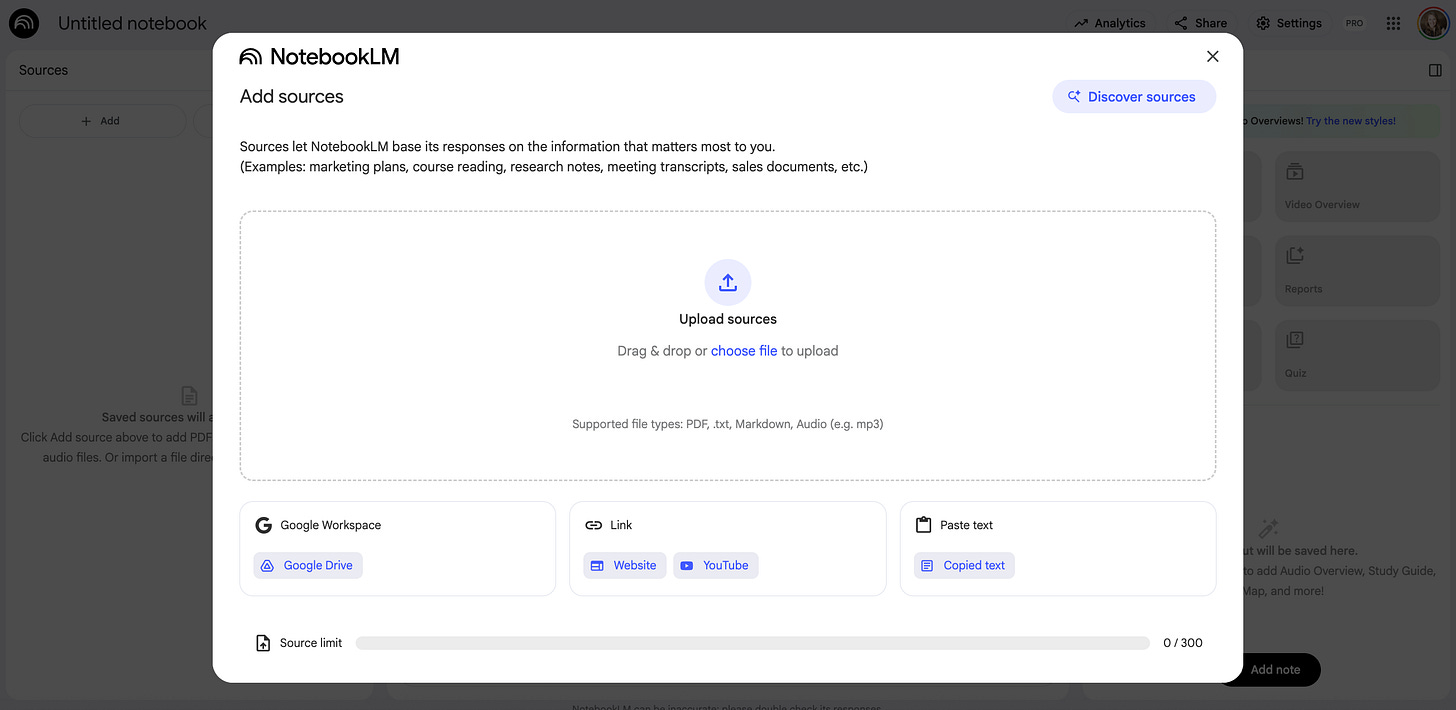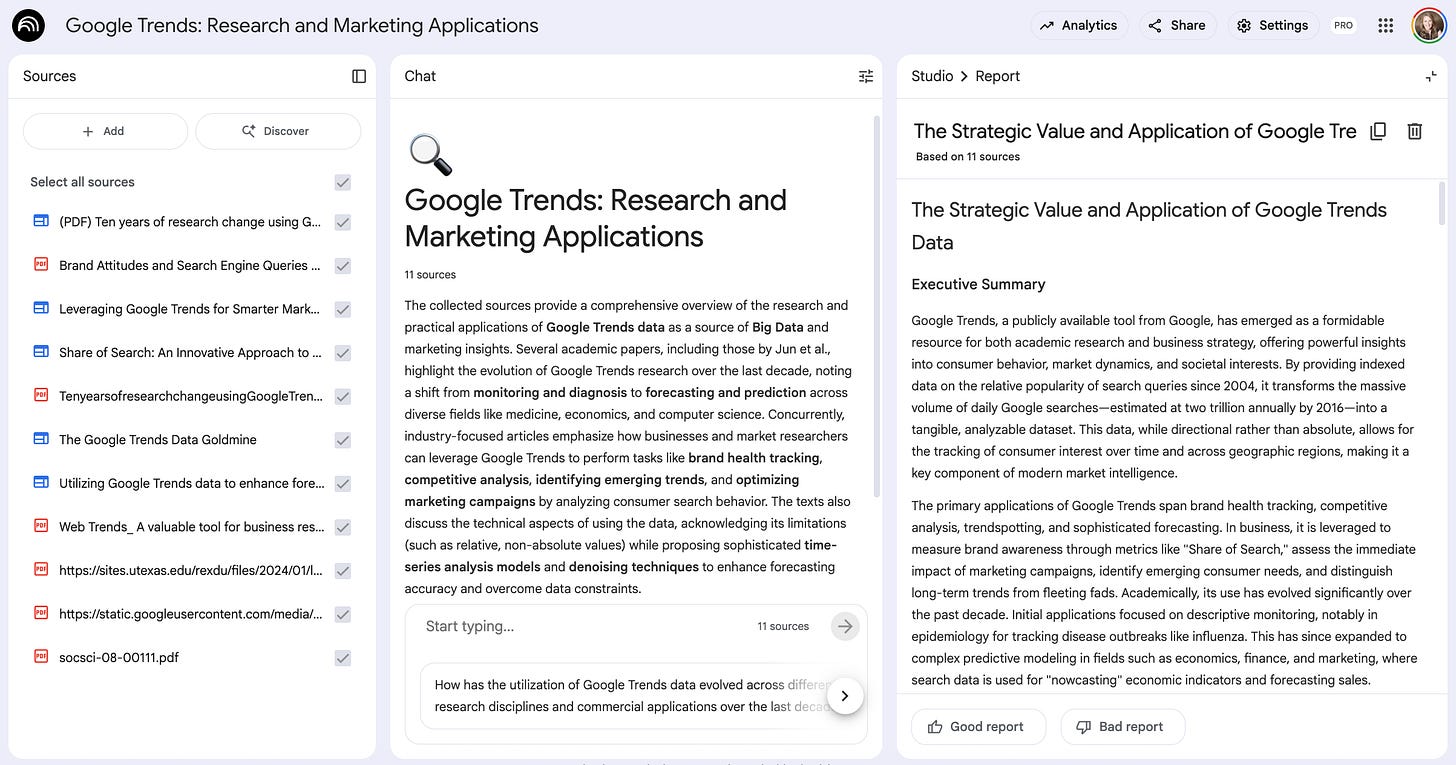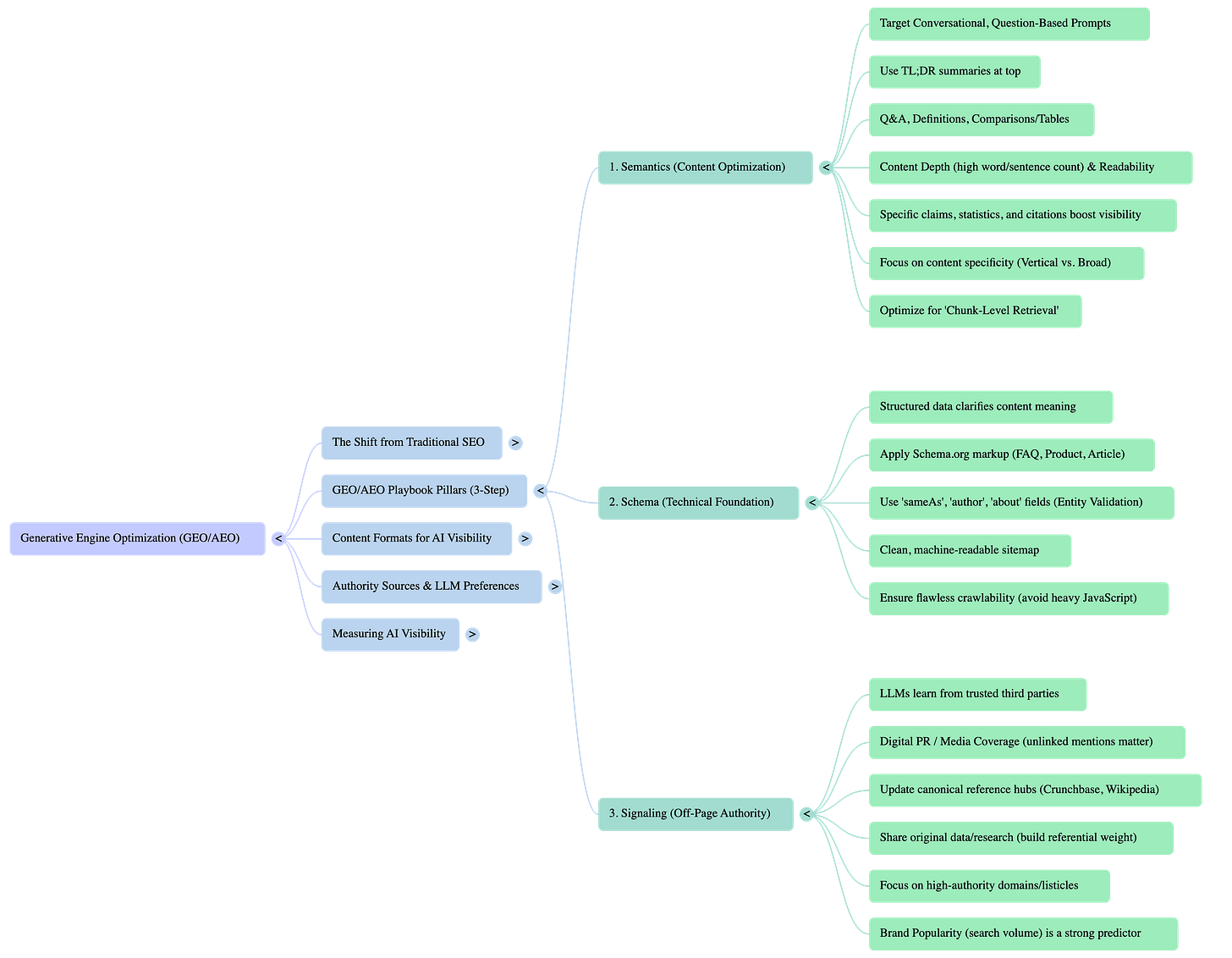Information Into Insight: How I Actually Use NotebookLM Day to Day
The AI assistant that helps me work faster, connect ideas, find patterns, and turn research into real insight.
Everyone’s always talking about ChatGPT, Claude, and Gemini, the flashy all-purpose AIs that promise to do it all. But the most genuinely useful AI tool I’ve used this year isn’t one of them, it’s NotebookLM.
Unlike the major LLM chatbots, NotebookLLM isn’t trying to do everything. Instead, it’s really, really good at one thing: organizing and synthesizing information.
NotebookLM is what’s known as source-grounded AI. Instead of pulling from the entire internet (and occasionally making things up), NotebookLM only uses the documents you feed it. That means it can’t hallucinate. Every answer it gives is based on something it can point back to in the sources you provided.
What makes this really powerful is how it bridges the gap between raw information and real understanding. You can upload dozens of files, then ask questions, generate summaries, or synthesize connections across all your materials. Whether you’re a founder dissecting user interviews or a creator turning research into content, NotebookLM is like having a research assistant who actually reads everything for you and remembers it perfectly.
Despite that, NotebookLM is barely mentioned in most AI tool discussions. This is surprising because it quietly solves one of the biggest problems in AI: trust. Once you start using it, you realize it’s not just a productivity hack; it’s a thinking partner built on evidence.
In this article, I’ll break down what makes NotebookLM special, how it works, and the surprisingly creative ways you can use it to think faster, research better, and make smarter decisions.
How NotebookLM Works (and Why It’s Different)
Everything in NotebookLM starts with a notebook; a workspace for one topic, project, or idea. Think of it as a self-contained research hub built around your specific goal: exploring a new market, writing a report, or organizing everything you’ve learned about a niche.
Once your notebook is created, you upload your sources. NotebookLM currently supports the following formats:
Uploaded files including PDF, .txt, markdown, and audio (e.g. mp3).
Files imported from your Google Drive.
Website URLs, including YouTube videos.
Pasted text.
You can add up to 50 sources per notebook for free (up to about 500,000 words each), giving you room for hundreds of pages of material. If you have a Google AI Pro plan (which comes with loads of features across Google AI products, as well as file storage), you can add up to 300 sources.
When you add these files, NotebookLM automatically indexes, embeds, and connects them. It doesn’t just store them, it understands them. From that moment on, you can:
Chat with your notebook. Ask questions across all your materials and get grounded, cited answers. It’s not guessing; it’s pulling directly from your uploads.
Generate summaries and outlines. NotebookLM can condense long reports into digestible summaries or create outlines for blog posts, presentations, or strategies based on your content.
Visualize with mind maps. It can create structured mind maps to help you see how your ideas connect, perfect for turning research into clear frameworks or storylines.
Extract insights and contradictions. Ask things like “What are the main arguments across these sources?” or “Where do they disagree?” and it will synthesize a balanced view.
Create Notebook Guides. These are auto-generated overviews of your materials, summarizing the key people, themes, and takeaways across everything you’ve uploaded.
Each notebook becomes its own mini knowledge model, focused entirely on your materials, not the internet. That’s what makes it so powerful: it gives you the analytical intelligence of an AI assistant, but grounded entirely in your own data.
5 Ways I Use NotebookLM
Here are a few ways I actually use NotebookLM in my own work to learn faster, think more deeply, and make better decisions.
1. Turning Reading Into Retention
Most of us don’t have a reading problem; we have a retention problem. We highlight, bookmark, and screenshot our way through endless articles, papers, and books… then promptly forget what we learned.
NotebookLM quietly fixes that by helping me go from passive reading to active learning. For example, whenever I come across a great Python tutorial (maybe a YouTube walkthrough or a blog post explaining a new library), I’ll drop it into my “Python” notebook and ask it to break the material down in different ways:
“Explain this concept in plain language.”
“What are the key takeaways I should remember a month from now?”
“Create five questions that test whether I really understand this.”
It’s like having a personal tutor who meets me exactly where my curiosity is that day.
Over time, these conversations turn scattered tutorials into understanding that sticks. Instead of revisiting the same videos or docs every time I forget something, I can ask my Python notebook to remind me of key principles, syntax, or examples.
NotebookLM can even generate flashcards or quizzes to help reinforce new material, making it perfect for learning technical skills where repetition and recall matter.
2. Synthesizing Research Faster
When exploring a topic (like brand or advertising trends), I can easily lose half a day bouncing between browser tabs, PDFs, and YouTube videos. Every source has something valuable, but consuming them and connecting all the dots takes forever.
That’s where NotebookLM shines. Instead of trying to piece together insights manually, I upload all the relevant studies into one notebook. Then I ask it to do what my brain wants to do, but can’t always keep up with:
Find the key arguments and through-lines across sources.
Highlight contradictions or gaps.
Summarize what’s genuinely new or surprising.
It’s not about outsourcing thinking; it’s about accelerating it. NotebookLM gives me the scaffolding so I can spend more time on interpretation and application.
For example, when I was planning my analysis of Super Bowl ads, I uploaded more than a dozen studies that examined the usefulness of Google Trends for estimating brand metrics. This helped me quickly validate a measurement approach, allowing me to focus on the actual analysis.
What makes NotebookLM powerful is that it doesn’t just summarize information; it helps you see where knowledge diverges. Over time, as your notebooks grow, you’re not just analyzing what’s new; you’re comparing it against everything you’ve already learned.
3. Structuring and Outlining Content
When I sit down to write, I’m usually swimming in notes: quotes, studies, fragments of ideas. The hard part isn’t finding something to say; it’s shaping all that raw material into a clear argument.
That’s where NotebookLM earns its keep. Before I ever open a blank doc, I’ll upload my research, partial drafts, and old outlines into a single notebook and ask it to help me make sense of the mess.
That’s where the Mind Map and Reports features come in.
If I’m still in the idea stage, I’ll use Mind Map to visualize the relationships between themes. It instantly turns my scattered notes into a structured web of connections, perfect for spotting clusters, gaps, or redundant ideas. Sometimes I realize two concepts I thought were separate are actually variations of the same point.
Once the direction feels clear, I’ll generate a briefing doc from the Reports list. It’s like asking NotebookLM to brief me on my own material. The report organizes everything into a digestible summary of key insights and quotes, so I can see the full picture before I write a single sentence.
In minutes, I go from scattered insights to a coherent skeleton. For example, when I was drafting my primer on generative engine optimization (GEO), I wanted to ensure that I covered all the key “ranking factors” without making it overwhelming or complicated. NotebookLM helped me think through the most effective way to bucket the factors into a simple list anyone can use to get started with GEO. Then, I got to work writing and explaining each one.
What used to take hours of re-reading and rearranging now happens in one focused session. And because the notebook keeps my sources attached, I can trace every insight back to its origin, no lost citations or context.
It’s not a writing tool so much as a thinking tool. One that makes the blank page feel a lot less blank.
4. Building a Living Knowledge Base
Plenty of tools can help you store information, but only NotebookLM helps you think along with it. I treat each notebook like a living domain expert: a mini-intelligence trained on the sources I trust most.
For example, each time I come across a new SEO study or resource from a high-quality source, I drop it into my SEO notebook. But that’s just when it gets interesting. NotebookLM doesn’t just summarize the new input; it contextualizes it within everything else you’ve added before. Over time, patterns emerge that wouldn’t have been visible in isolation.
Whenever I’m looking for a new opportunity or troubleshooting a problem, I don’t start from scratch. I go straight to the relevant notebook and ask it what it already knows.
Questions like:
“Given everything in this notebook, where are the biggest unexplored opportunities?”
“What’s changed recently that might affect my current strategy?”
“What patterns or contradictions suggest that I’m missing something important?”
“I’m experiencing [problem], what might be causing it?”
NotebookLM responds with the context of everything I’ve fed it and surfaces insights I might’ve forgotten or missed. It’s like having an expert consultant who’s been quietly studying your material for months.
And the best part? You can export or reuse insights anywhere, including in your writing, course materials, or client decks. NotebookLM becomes the quiet backbone of your intellectual workflow: always learning, always ready to help you see your own ideas more clearly.
5. Building a Brain for Every Client
For my client and consulting work, I keep a dedicated notebook for each client, almost like a private AI-powered brain that grows alongside the project.
Every call transcript, brief, deck, and follow-up note goes straight into that client’s notebook. Over time, it becomes a complete, searchable memory of our collaboration.
When I upload a new transcript, I can immediately ask things like:
“Summarize the main themes from this call.”
“How does this update compare to what they said last month?”
“What open questions or next steps have we discussed but not resolved yet?”
NotebookLM remembers the full context of our history together, so I don’t have to worry about missing anything. It can reference old decisions, past versions of goals, and even the exact language the client uses to describe their challenges.
That continuity changes everything. Instead of starting every call by reorienting myself, I can ask higher-order questions like, “If we were to revisit this in six months and you were thrilled with the result, what would you say needed to happen between now and then?” It’s like having a chief of staff who quietly tracks every thread for you, except it’s organized around that one client’s universe.
By the end of a project, that notebook doubles as a record of insights, strategies, and outcomes, something I can reference when writing case studies or designing new offers.
The best part? Each notebook feels alive. Add one more transcript, and it instantly understands how that new piece fits into the whole story.
These five workflows barely scratch the surface of what’s possible. The real magic happens when you tailor NotebookLM to your own unique workflows
To endless possibilties,
Casandra
🎁 Premium Bonus: Really Good Business Ideas Notebook
Want to see what NotebookLM can really do? I’ve built something special for paid subscribers: a shared NotebookLM workspace packed with Really Good Business Ideas content. You get access to all the articles I’ve published, including growth tactics, business opportunities, tool explainers, business basics, and more.
Inside, you’ll be able to:
Ask NotebookLM questions about my research and analyses.
Generate summaries, outlines, or mind maps from the content.
See how the tool connects ideas across different business concepts.
Experiment with your own questions, summaries, and analyses.
It’s a hands-on way to experience how source-grounded AI transforms reading into understanding, and it gives you an entirely new way to interact with my work. Note: Since NotebookLM can’t access paid articles, I’ve uploaded them as PDFs instead.





